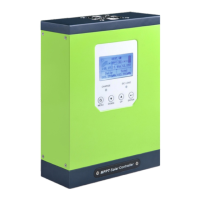Thank you for choosing the TY series MPPT controller. It is a new generation of MPPT controller,
and its the research and development is based on the latest technology, It is a representative of the
latest level of development of PV technology products. Many Excellent performance of MPPT
products are shown as follows:
•
Ex
cellent cooling design and intelligent control of the cooling fan.
•
The innovative m
aximum power of tracking can significantly improve the energy efficiency of
systems, the conversion rate is ≥97%.
•
Quickly sc
an the entire l-V curve for a few seconds to track the maximum power point.
•
S
ealed, colloid, op
en of lead-acid battery and lithium battery series charging program optional.
•
The controller has
the automatic protect function for overcharge, over discharge, overload, short
circuit et
c.
•
The Rs485 c
ommunication interface can do multi-machine communication. The communication
distance is 1 KW, that can c
ommunicate with PC board, in order to check the controller operating
parameters.
This controller is used in off-grid solar system (independent system),it can automatically adjust
the charge and discharge. The MPPT controller utilizes an advanced tracking algorithm to obtain
the maximum power of the PV module to charge the battery. At the same time, the low voltage
disconnect (LVD) function prevents battery damages caused by excessive discharge. The MPPT
controllerDs battery charging process is optimized to extend battery life and improve system
performance. Its comprehensive self-test function and electronic protection function to avoid the
controller damage caused by the installation error and system failure. Although the TY-series MPPT
controller is easy to operate and use, but in order to make better use all the functions and improve
your PV system, please read this manual carefully.
•
The Advantage condition to compare with the traditional controller
When the sy
stem charging, the traditional controller needs directly connect the solar array to
the battery. This requires that the solar array operate normallybelow the Vmp voltage range.
For example, in a 12V system, the battery voltage range usually is 11- 15V, but the solar
array Vmp voltage usually is about 16-17V.
The following figures show t
he current, voltage and output power curves for a typical standard
rated voltage of 12V off-grid solar battery.
The TY-series MPPT controller utilizes maximum power point tracking technology to extract
the maximum power from the solar array to charge the battery. The maximum power point tracking
mode is full automatic and no user adjustments are required. When the maximum power point of the
array changes with ambient conditions, the controller automatically tracks the maximum power
point ofthe array to ensure that the maximum energy of the day is obtained from the solar array.
•
Current Enhancement
In most cases, the maximum power point tracking technology will increase the charging current of
the system. Assuming a system may have 10 amps of current flowing from the solar array into the
MPPT controller, then will have 12 amps of current flows from the MPPT controller to the battery.
MPPT controller does not generate current! The energy input to the MPPT controller is equal to its
output energy. Since the power is the production of voltage and current (volts x amperes),
The following situation was established:
(1 )MPPT controller input energy = MPPT controller output energy (2)lnput voltage x input current =
output voltage x output current
*
Suppose the efficiency 100%, ignoring the power loss of during wire and conversion. If the maximum
power point voltage Vmp ofthe solar array is larger than the battery voltage, the battery charge
c
urrent must be proportionally larger than the solar array output current, so that the input and output
power can be balanced. The greater difference between the Vmp voltage and the battery voltage, the
greater current enhancement. Current enhancement is extremely important in the system, because
the maximum power point Vmp voltage of solar panel in a system is usually higher than the battery
voltage.
Solar PV array maximum power point voltage is the maximum voltage of out power (Ampere x
voltage), it is in the " knee " of solar PV array l-V curve as shown above the left figure. Since the
traditional controller does not always operate in the PV array Vmp, the energy is wasted, which
can be used to charge the battery and supply power to the system load. The greater difference
between the battery voltage and the Vmp ofthe solar PV array, the more energy is wasted. The
MPPT controller will always operate with the maximum power point, that can reduce energy
waste to compare with traditional controller.
The Vmp ofthe solar PV array will decrease as the temperature of the array increase. In hot
weather, Vmp may be close to or even lower than the battery voltage. In this case, the MPPT
controller will have less or can' t obtain the energy compared to traditional controller. However,
once the nominal voltage ofthe PV module is higher than the battery voltage, the Vmp of the PV
module will always be higher than the battery voltage. In addition, the MPPT controller has a
significant advantage even in hot weather, due to the reduced current ofthe solar array and the
saving wire.

